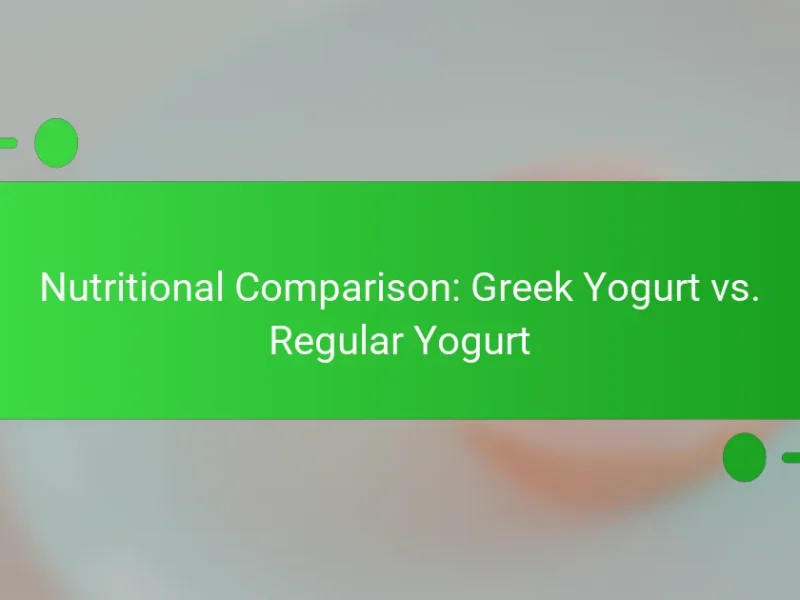Greek yogurt is a strained type of yogurt that offers a thicker consistency, higher protein content, and lower sugar levels compared to regular yogurt. This article explores the various flavors of Greek yogurt, highlighting classic options such as plain, honey, and fruit varieties, as well as emerging exotic flavors like lavender, matcha, and hibiscus. The nutritional benefits, including probiotics and vitamins, contribute to Greek yogurt’s popularity among health-conscious consumers. Additionally, the growing trend towards innovative flavors reflects the evolving preferences of consumers seeking unique culinary experiences.

What is Greek Yogurt and How is it Different from Regular Yogurt?
Greek yogurt is a type of yogurt that is strained to remove whey, resulting in a thicker consistency. This process gives Greek yogurt a creamier texture compared to regular yogurt. Additionally, Greek yogurt contains more protein, often double that of regular yogurt. The straining process also reduces the sugar content in Greek yogurt. Regular yogurt typically retains more liquid and has a milder flavor. Greek yogurt is often used in recipes for its richness. Nutritionally, Greek yogurt offers probiotics, calcium, and vitamins. These differences make Greek yogurt a popular choice for health-conscious consumers.
What are the key characteristics of Greek Yogurt?
Greek yogurt is a thick, creamy dairy product known for its high protein content. It is made by straining regular yogurt to remove whey, resulting in a denser texture. Greek yogurt typically contains around 10 grams of protein per serving, significantly more than standard yogurt. It is lower in sugar and carbohydrates, making it a popular choice for health-conscious consumers. The fermentation process gives it a tangy flavor, which can vary by brand. Greek yogurt is versatile and can be used in both savory and sweet dishes. It also contains probiotics, which are beneficial for gut health. The fat content can vary, with options available in non-fat, low-fat, and full-fat varieties.
How is the straining process significant in creating Greek Yogurt?
The straining process is crucial in creating Greek yogurt. This method removes excess whey from regular yogurt. The result is a thicker and creamier texture. Straining also concentrates the flavors of the yogurt. This enhances its taste profile compared to unstrained yogurt. Additionally, the process increases the protein content significantly. Greek yogurt typically contains about twice the protein of regular yogurt. The straining process thus transforms the yogurt into a distinct culinary product.
Why does Greek Yogurt have a thicker consistency?
Greek yogurt has a thicker consistency due to the straining process it undergoes. This process removes whey, the liquid portion of yogurt. As a result, the remaining yogurt is denser and creamier. Greek yogurt typically contains about twice the protein of regular yogurt. The higher protein content contributes to its thicker texture. Additionally, the fermentation process used in making Greek yogurt also affects its consistency. The specific bacterial cultures used can create a firmer product. Overall, these factors combine to give Greek yogurt its characteristic thickness.
What nutritional benefits does Greek Yogurt provide?
Greek yogurt provides several nutritional benefits. It is high in protein, offering approximately 10 grams per 100 grams serving. This protein content supports muscle growth and repair. Greek yogurt is also rich in probiotics, which promote gut health. It contains calcium, essential for bone strength, with about 110 mg per 100 grams. Additionally, it is lower in sugar compared to regular yogurt, making it a healthier option. Greek yogurt is a source of B vitamins, particularly B12, which is important for energy metabolism. These attributes make Greek yogurt a nutritious choice for a balanced diet.
How does Greek Yogurt compare to regular yogurt in protein content?
Greek yogurt typically contains more protein than regular yogurt. On average, Greek yogurt has about 10 grams of protein per 100 grams. In contrast, regular yogurt usually has around 4-5 grams of protein per 100 grams. This difference is due to the straining process used in making Greek yogurt, which removes whey and concentrates the protein content. Studies indicate that the protein content in Greek yogurt can be nearly double that of regular yogurt. This higher protein content makes Greek yogurt a popular choice for those seeking to increase their protein intake.
What are the health benefits associated with consuming Greek Yogurt?
Greek yogurt offers several health benefits. It is high in protein, providing approximately 10 grams per serving. This protein content supports muscle growth and repair. Greek yogurt also contains probiotics, which promote gut health. These beneficial bacteria can enhance digestion and boost the immune system. Additionally, it is rich in calcium, essential for strong bones and teeth. Greek yogurt is lower in carbohydrates than regular yogurt, making it suitable for low-carb diets. Studies show that regular consumption can aid in weight management. Overall, Greek yogurt is a nutritious option that contributes to various aspects of health.

What are the Classic Flavors of Greek Yogurt?
The classic flavors of Greek yogurt include plain, honey, and fruit varieties such as strawberry and blueberry. Plain Greek yogurt is the most basic form, known for its creamy texture and tangy taste. Honey-flavored Greek yogurt combines sweetness with the yogurt’s natural tartness. Strawberry and blueberry flavors add fruitiness, appealing to those who enjoy a sweeter option. These classic flavors are widely available and popular among consumers.
What are the most popular classic flavors of Greek Yogurt?
The most popular classic flavors of Greek yogurt are plain, honey, and vanilla. Plain Greek yogurt is widely consumed for its versatility. It serves as a base for both sweet and savory dishes. Honey-flavored Greek yogurt combines the tartness of yogurt with natural sweetness. This flavor is often enjoyed as a snack or breakfast option. Vanilla Greek yogurt adds a rich, aromatic taste. It is commonly used in desserts or eaten alone. These classic flavors are staples in many grocery stores and are favored for their taste and nutritional benefits.
Why is plain Greek Yogurt a staple in many diets?
Plain Greek yogurt is a staple in many diets due to its high protein content and low sugar levels. It typically contains about 10 grams of protein per 100 grams, making it an excellent source of nutrition. This high protein content supports muscle maintenance and satiety. Additionally, plain Greek yogurt is lower in carbohydrates compared to regular yogurt, which appeals to those monitoring their sugar intake. It also contains probiotics, which promote gut health. The versatility of plain Greek yogurt allows it to be used in both savory and sweet dishes. Its creamy texture enhances recipes, making it a popular choice for smoothies, dressings, and desserts. These attributes contribute to its widespread use in various dietary plans.
How do fruit-flavored Greek Yogurts enhance taste and nutrition?
Fruit-flavored Greek yogurts enhance taste and nutrition by combining creamy texture with natural sweetness from fruits. This results in a more enjoyable flavor profile compared to plain yogurt. The addition of fruits increases the vitamin and antioxidant content. For example, strawberries provide vitamin C, while blueberries are rich in antioxidants. These nutrients support immune function and overall health. Additionally, fruit-flavored Greek yogurts often contain probiotics, which aid digestion. The combination of taste and nutrition makes them a popular choice for healthy snacking.
How can classic flavors be used in recipes?
Classic flavors can be used in recipes by incorporating traditional ingredients that enhance the dish. For example, using vanilla in desserts adds warmth and sweetness. Citrus flavors, like lemon or orange, can brighten savory dishes and dressings. Herbs such as basil and thyme can elevate the taste of sauces and marinades. Spices like cinnamon and nutmeg can add depth to baked goods and beverages. Each classic flavor complements the natural taste of Greek yogurt, creating a balanced profile. Recipes can blend these flavors to achieve both comfort and innovation, appealing to a wide range of palates.
What are some easy recipes using classic Greek Yogurt flavors?
Greek yogurt can be used in various easy recipes that highlight its classic flavors. For a simple Greek yogurt parfait, layer Greek yogurt with granola and fresh berries. This recipe combines the tangy flavor of yogurt with the sweetness of fruit. Another easy option is a Greek yogurt dip. Mix Greek yogurt with garlic, lemon juice, and herbs for a flavorful dip. This can be served with vegetables or pita chips. Additionally, Greek yogurt can be used in smoothies. Blend Greek yogurt with spinach, banana, and almond milk for a nutritious drink. These recipes utilize the creamy texture and tangy taste of classic Greek yogurt effectively.
How can Greek Yogurt be incorporated into breakfast dishes?
Greek yogurt can be incorporated into breakfast dishes in various ways. It can be used as a base for smoothies, adding creaminess and protein. Mixing Greek yogurt with fruits creates a nutritious parfait. It can also be spread on toast, topped with honey or fruit. Greek yogurt serves as a substitute for sour cream in breakfast burritos. Adding it to oatmeal enhances texture and flavor. It can be blended into pancake or waffle batter for added protein. Using Greek yogurt in fruit salads adds richness and tang. Each of these methods boosts nutritional value while enhancing the overall taste of breakfast dishes.

What Exotic Flavors of Greek Yogurt Are Emerging?
Emerging exotic flavors of Greek yogurt include lavender, matcha, and hibiscus. Lavender offers a floral note that enhances the creamy texture. Matcha adds a unique earthy flavor along with health benefits. Hibiscus provides a tart and vibrant profile, appealing to adventurous palates. These flavors reflect a trend towards innovative and diverse yogurt options. The rise of plant-based diets influences these unique flavor profiles. Consumers seek out new experiences in their food choices. This trend is supported by market research indicating increased interest in gourmet yogurt varieties.
What are some unique and exotic flavors of Greek Yogurt available today?
Unique and exotic flavors of Greek yogurt include lavender, cardamom, and passion fruit. These flavors offer a distinctive twist on traditional yogurt. Lavender provides a floral note, often paired with honey. Cardamom adds warmth and spice, creating a unique taste experience. Passion fruit introduces a tropical sweetness that enhances the creamy texture. Other notable flavors include fig and pistachio, which blend sweetness with nuttiness. These exotic options are increasingly available in specialty grocery stores. They cater to adventurous palates seeking new culinary experiences.
How do cultural influences shape the flavors of Greek Yogurt?
Cultural influences shape the flavors of Greek yogurt by incorporating local ingredients and traditional practices. In Greece, yogurt is often flavored with honey and nuts, reflecting Mediterranean dietary habits. Regional variations exist, with some areas adding herbs or spices unique to their culture. The use of fruits like figs or cherries is common, showcasing local agricultural products. Additionally, the preparation methods differ, affecting texture and taste. Cultural traditions dictate how yogurt is consumed, whether as a standalone dish or part of a meal. These practices contribute to the diverse flavor profiles found in Greek yogurt today. The historical significance of yogurt in Greek cuisine also plays a role in flavor development.
What ingredients are commonly used in exotic Greek Yogurt flavors?
Exotic Greek yogurt flavors commonly include ingredients such as honey, cardamom, and saffron. Other popular additions are fig, pomegranate, and rose water. These ingredients enhance the yogurt’s taste and provide unique flavor profiles. Honey adds sweetness, while cardamom and saffron introduce aromatic spices. Fig and pomegranate contribute fruity notes. Rose water imparts floral undertones. These combinations create a diverse range of exotic flavors in Greek yogurt.
How can exotic flavors enhance culinary experiences?
Exotic flavors can significantly enhance culinary experiences by introducing unique taste profiles. They stimulate the palate and create memorable dining moments. For instance, flavors like cardamom or saffron add depth and complexity to dishes. These flavors can transform traditional recipes into innovative creations. Research indicates that diverse flavors can increase meal enjoyment and satisfaction. According to a study published in the Journal of Culinary Science, incorporating exotic ingredients can elevate the sensory experience of food. This enhancement often leads to a greater appreciation of cultural cuisines. Overall, exotic flavors encourage culinary exploration and creativity, enriching the overall dining experience.
What are some creative ways to use exotic Greek Yogurt flavors in cooking?
Exotic Greek yogurt flavors can be used in various creative cooking applications. Incorporate them into salad dressings for a unique twist. Use flavors like mango or passion fruit to enhance fruit salads. They can also be mixed into marinades for meats, providing a tenderizing effect. Use spicy flavors in dips for a bold appetizer option. Incorporate yogurt into smoothies for added creaminess and flavor. Use flavored yogurt as a topping for desserts like pancakes or waffles. Create unique sauces for grilled vegetables by blending yogurt with herbs and spices. Lastly, use exotic flavors in baking to add moisture and a flavor boost to muffins or cakes.
How do exotic flavors appeal to different taste preferences?
Exotic flavors appeal to different taste preferences by introducing unique taste combinations. These flavors often blend sweet, savory, and spicy elements. This variety can attract adventurous eaters seeking new experiences. For instance, ingredients like cardamom or saffron may intrigue those who enjoy aromatic spices. Additionally, exotic flavors can evoke cultural connections, enhancing the eating experience. Studies show that novelty in food can increase enjoyment and satisfaction. Therefore, exotic flavors cater to diverse palates by offering distinctive and memorable taste experiences.
What tips can help you choose the best Greek Yogurt flavor for your palate?
To choose the best Greek yogurt flavor for your palate, start by identifying your taste preferences. Consider if you enjoy sweet, savory, or tart flavors. Look for labels that highlight flavor profiles, such as vanilla, honey, or fruit-infused options. Sampling different brands can help you discover unique flavors. Check for added sugars and ingredients to align with your dietary goals. Reading reviews can provide insights into popular flavors among consumers. Lastly, consider the fat content, as this can affect the taste and creaminess of the yogurt.
Greek yogurt is a strained dairy product known for its thicker consistency, higher protein content, and lower sugar levels compared to regular yogurt. This article explores the various flavors of Greek yogurt, ranging from classic options like plain and honey to exotic varieties such as lavender and matcha. Key nutritional benefits, including probiotics and calcium, are highlighted, along with the culinary versatility of Greek yogurt in recipes. Additionally, the influence of cultural trends on flavor development and tips for selecting the best flavor for individual preferences are discussed, providing a comprehensive overview of Greek yogurt’s unique attributes and uses.


